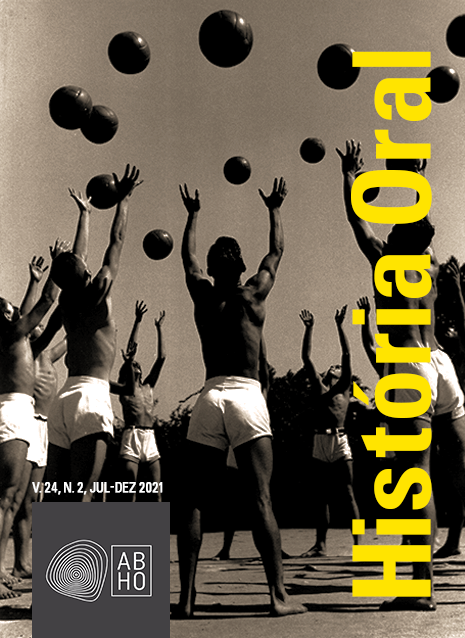A disseminação do Muay Thai no Brasil: narrativas e memórias dos mestres pioneiros
DOI:
https://doi.org/10.51880/ho.v24i2.1181Palavras-chave:
Boxe Tailandês, História Oral, Nélia Naja, Mixed Martial ArtsResumo
Muay Thai has become one of the most practiced martial arts in the country, after the success of Brazilian fighters in MMA events held since the 1990s. This article aims to analyze, through narratives, the process of insertion and dissemination of the sport in Brazil. The first black belts formed by Nélio Naja, the supposed introducer of this martial art in the country, participated in this study. It was concluded that when he abandoned Taekwondo and started Muay Thai in the city of Curitiba (PR), Nélio Naja
prospered, fostering the construction of the hero's myth and the construction of a martial art identity. Nélio Naja, in order to establish himself as an introducer in Brazil, had to create some versions of how he got to know the sport, becoming a consensus among practitioners. In a short time, Muay Thai started to be practiced in Rio de Janeiro (RJ) and São Paulo (SP). In these places, others pioneers also have tried to establish themselves as precursors.
Referências
ALBERTI, Verena. Manual de história oral. Editora FGV, 2013.
ALBERTI, Verena. Histórias dentro da história. In: PINSKY, Carla Bassanezi (Org.). Fontes históricas. São Paulo: Contexto, 2008. p. 155-202.
ALVES, Luiz; MARIANO, Artur. Muay Tai – Boxe Tailandês. São Paulo: Editora On Line, 2007.
BOWMAN Paul. Deconstructing Martial Arts. Cardiff: Cardiff University Press, 2019.
CAMPBELL, Joseph. O Herói de Mil Faces. Cholsamaj Fundacion, 2004.
CANDAU, J. Memória e Identidade. Contexto. 1. ed. São Paulo, 2011.
DIÁRIO DO PARANÁ. Programação Cultural, Círculo Militar do Paraná, 1980. Disponível em: http://memoria.bn.br/DocReader/docreader.aspx?bib=761672&pasta=ano%20198&pesq=Mu ay%20thai >. Acesso em: 10 abr. 2021.
GAZETA DO POVO. Cidade foi escolhida por intuição mística, 2007. Disponível em: https://www.gazetadopovo.com.br/esportes/cidade-foi-escolhida-por-intuicaomistica-adr1kmw3edrpwfusnk0wg8z0u/>. Acesso em: 10 abr. 2021.
HOLLANDA, Bernardo Borges Buarque de. Futebol, memória e relatos orais: a trajetória de ex-jogadores da Seleção Brasileira e as narrativas memorialísticas das Copas do Mundo FIFA, entre 1954 e 1982. História Oral, v. 20, p. 101-123, 2017.
JUKPING, Sukrittaya. Re-inventing the martial “hero” and the weak “beauty queen” through the sporting identity: a tale of two competing gendered bodies, Muay Thai and the stability of the Thai nation-state. Sport in History, v. 40, n.3, p. 296-312, 2020.
LA CANCHA, Taekwondo Hall of Honor. Disponível em: http://www.lacancha.com/taekwondohallofhonor.html. Acesso em: 10 abr. 2021.
LEE, Woo-Jae. Defesa Pessoal: Hoshin-sull do taekwondo. 1.ed. – Santos, SP: Bueno Editora, 2019.
LEE, Woo-Jae. Defesa Pessoal: Hoshin-sull do taekwondo. 1.ed. – Santos, SP: Bueno Editora, 2019.
LISE, Riqueldi Straub. Cerceamentos, coerções e esportividade no Ultimate Fighting Championship (UFC). 2017.
MYERS, Tony; NEVILL, Alan; NAKEEB, Yahya Al. A comparison of the effect of two different judging systems on the technique selection of Muay Thai competitors. Journal of Human Sport and Exercise, vol. 8, n. 3, p. 761-777, 2013.
MOOKDARSANIT, Pakpoom; MOOKDARSANIT, Lawankorn. A content-based image retrieval of Muay-Thai folklores by salient region matching. International Journal of Applied Computer Technology and Information Systems, v. 7, n. 2, p. 21-26, 2018.
MÜLLER, Edmilson Borges; ETO, Jorge. História Oral do Taekwondo em Cuiabá-MT: Os primeiros Mestres. Connection Line, n. 4, 2014.
NODARI, Eunice Sueli. A dor do esquecimento: as marcas da ditadura Vargas no Oeste de Santa Catarina. História Oral, v. 12, n. 1-2, p. 157-176, 2011.
POLLAK, Michael. Memória, esquecimento, silêncio. Revista Estudos Históricos, v. 2, n. 3, p 3-15, 1989.
POLLAK, Michael. Memória e identidade social. Revista Estudos Históricos, v. 5, n. 10, p.200-215, 1992.
PORTELLI, Alessandro. História oral como arte da escuta. São Paulo: Letra e Voz, 2016.
PORTELLI, Alessandro. O que faz a história oral diferente. Projeto História, São Paulo, v. 14, fev.1997.
RIOS, Gleyson Batista. O processo de esportivização do Taekwondo. 2005.
REIS, Caudia; RODRIGUES, José de Alemida. Diamante: a história de Luiz Alves, lenda do Muay Thai e do MMA. 1.ed. – São Paulo: Forma & Conteúdo, 2018.
ROSA, Nina Gabriela Moreira Braga. Identidade: Anthony Giddens e Norbert Elias. Humanidades em diálogo, v. 1, n. 1, p. 135-148, 2007.
RUDNICK, Fernando. A vida de ermitão do mestre da luta. Curitiba, 24 jan. 2015. Disponível em: https://www.gazetadopovo.com.br/esportes/lutas/a-vida-de-ermitao-do-mestre-da-luta-ej6yq4j6x0ojt5x52fgv5332m/ . Acesso em: 10 abr. 2021.
THOMPSON, Paul. A voz do passado – história oral. 3. ed. Rio de Janeiro: Paz e Terra,1992.
WACQUANT, Loïc. Corpo e alma: notas etnográficas de um aprendiz de boxe. Rio de Janeiro: Relume Dumará, v. 41, 2002.
Downloads
Publicado
Como Citar
Edição
Seção
Licença
Copyright (c) 2021 História Oral

Este trabalho está licenciado sob uma licença Creative Commons Attribution-NonCommercial-NoDerivatives 4.0 International License.
A revista História Oral é licenciada de acordo com a atribuição Creative Commons BY-NC-ND 4.0 (Atribuição-NãoComercial-SemDerivações 4.0 Internacional). Dessa forma, os usuários da revista têm o direito de compartilhar livremente o material, copiando-o e redistribuindo-o em qualquer suporte e formato, desde que sem fins comerciais, fornecendo o crédito apropriado e não realizando mudanças ou transformações no material. Para maiores informações, ver: https://creativecommons.org/licenses/by-nc-nd/4.0/deed.pt_BR








